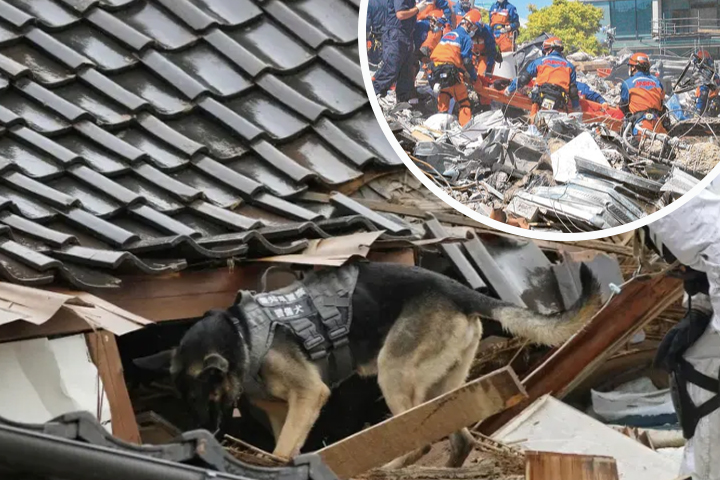


SUZU, Japan—As severe cold and torrential rain were forecast for Wednesday, Japanese rescue personnel and canine teams hurriedly combed through debris in what the prime minister described as a race against time following strong earthquakes that left at least 73 people dead in western Japan.
A 4.9 magnitude aftershock rocked Ishikawa prefecture and the surrounding areas on Wednesday. This was one of several after Monday's magnitude 7.6 temblor that was centered near Noto, some 300 kilometers (185 miles) from Tokyo on the opposite shore. Following the earthquake, certain locations saw waves that were greater than one meter (3 feet) in height.
Experts suggest that because the chances of life drastically decrease after the first 72 hours, these hours are particularly crucial for rescue operations.
“More than 40 hours have passed. This is a race against time, and I feel that we are at a critical moment,” Prime Minister Fumio Kishida told reporters. “We have received reports many people are still waiting for rescue under collapsed buildings.”
The Noto Peninsula's small shape has made it more difficult to access some villages. There were still spots without electricity, water, or cellular service.
According to Naomi Gonno, she and her kids left their home as it was about to collapse.
However, while her kids cried out, "Granma," Ms. Gonno noticed that her mother was stuck beneath the shattered house, only her hand showing. According to Ms. Gonno, she managed to push herself out via a narrow opening.
“I can’t believe we’re still alive,” she said. “We are living in fear.”
Relief workers distributed food, water, blankets, and other items. Search dogs accompanied firemen and military officials in their search for scores of people—the precise number is unknown—though many are believed to be trapped.
Heavy rain was predicted for Ishikawa, raising concerns about landslides and more damage to partially collapsed structures. Overnight lows of about 4 degrees Celsius (39 degrees Fahrenheit) were predicted.
Of the fatalities, Ishikawa prefectural officials reported that 39 occurred in Wajima city and 23 in Suzu. Five nearby towns received reports of the additional deaths. Numerous people are said to remain trapped beneath collapsed structures, despite the fact that the official death toll is yet unknown.
At least 25 of the more than 300 wounded individuals required major medical attention.
As refugees take shelter together, Ishikawa Gov. Hiroshi Hase urged everyone to utilize masks, disinfectant, and soap to prevent the spread of infectious illnesses. According to him, providing sufficient water supply and bathrooms for the displaced is of utmost importance.
There are about 33,000 individuals residing in evacuation camps, and some of them have reported feeling scared, hungry, and cold.
Yasuo Kobatake, who was wearing only one sock, fled his residence during Monday's earthquake. He claimed that the shaking threw him to the ground and that a concrete wall crashed into him, just missing him.
The only food he was consuming at the elementary school where he and others were taking refuge was rice balls and a few sips of water from paper cups. They didn't have blankets; they slept on cushions.
“It was so cold. I thought I’d freeze to death,” he said.
Following the earthquakes and tsunami, roads were blocked by dirt mounds, walls and pillars from destroyed residences were strewn over the ocean, and boats were left upturned in the water. A massive fire reduced a significant portion of Wajima City to ashes.
There might be additional significant earthquakes, officials cautioned.
Because of its numerous fault lines and volcanoes, Japan is prone to earthquakes. Northeastern Japan suffered extensive damage in 2011 as a result of a powerful earthquake, tsunami, and nuclear accident.
After the earthquake on Monday, nuclear reactors did not disclose any significant issues. A partial power outage occurred at the Shika nuclear reactor in Ishikawa, but backup power kept the vital cooling process going.
In the orderly, conformist, and comparatively crime-free nation of Japan, public service announcements are routinely distributed as warnings. Experts in disaster relief claim that's saving lives.
Tohoku University disaster science professor Takako Izumi stated that it takes time to plan logistics since roads are frequently blocked and big vehicles are unable to get through to give relief after an earthquake.
Assistance may need to be dropped from the skies or transported in by boat if land routes aren't available. She continued, saying that some individuals might not have reached an evacuation facility and that the winter cold increases health concerns.
“We need to accurately assess the damage first. And then a proper response can come, and what’s needed can reach the right places,” Ms. Izumi said.